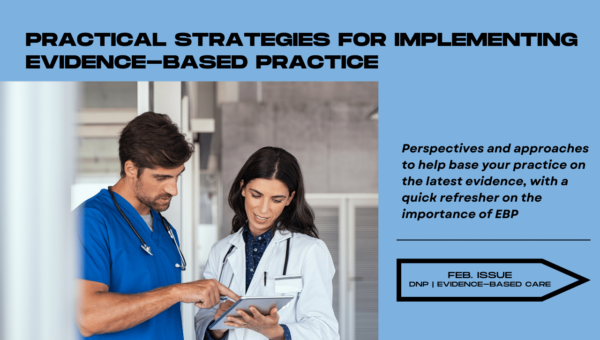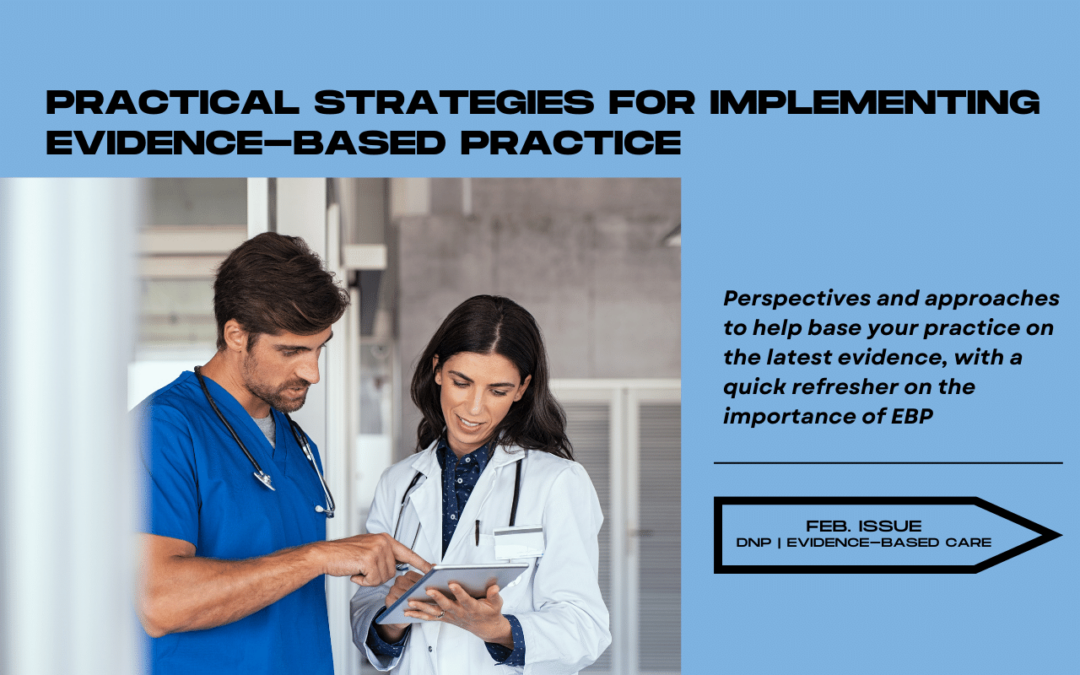Most nurses are familiar with evidence-based practice (EBP), using research-proven healthcare techniques to enhance patient care and the nursing environment and practices. And the benefits of EBP-led care are well documented. However, with all the positive results, EBP must consistently be taught or implemented in daily nursing practice.
Despite various studies that show the benefits of evidence-based practice for nurses, patients, and healthcare organizations, adopting the practice could be more widespread. Whether or not they work in an environment that supports EBP, nurses can learn more to apply EBP.
Why Use Evidence-based Practice?
What exactly is evidence-based practice? Kim M. Bissett PhD, MBA, RN, and director of the Center for Evidence-based Practice at the Johns Hopkins Institute, specializes in evidence-based practice and says, “At the most basic level, evidence-based practice (EBP) is a problem-solving approach to the decision-making process that uses the best available scientific and experiential evidence, coupled with critical thinking, to improve care.”
The method works, says Bernadette Melnyk, PhD, APRN-CNP, FAANP, FNAP, FAAN, vice president for Health Promotion and the Helene Fuld Health Trust Professor of Evidence-based Practice at The Ohio State University. “We have such a strong body of evidence that when EBP is implemented, that patient outcomes and safety is better,” she says. “We know that.”
With a patient-focused nursing priority, practicing nurses find inspiration in using innovative and successful methods. “Evidence-based practice is the most essential part of the nursing profession,” says Michael Williams, DNP, APRN, FNP-BC, a lead nurse practitioner at the Center for Health Empowerment-CHE in Austin, TX. “As a collective, organized workforce, it ensures we are keeping up with the demands of healthcare.” As healthcare delivery becomes more complex, Williams says evidence-based practice helps nurses answer their questions. “It allows us to be in a position to keep up with the demands and always be innovating.”
Patient care is only enhanced when identified and proven practices are followed. “EBP ensures patients are receiving the most current care using the best available evidence,” says Bissett. “By implementing evidence-based interventions, nurses can enhance the quality of care patients receive. For example, implementing evidence-based guidelines and protocols minimizes errors and complications such as medication errors, risk of infections, and unnecessary procedures that could lead to complications.”
Evidence-based Practice Is Good for Nurses
As Williams notes, nurses can pause and reexamine their actions when new evidence-based practices are introduced. “It’s exciting when we have the opportunity to learn something new,” he says. “It’s easy to get caught up in the day-to-day, giving us a chance to reset. When new guidelines pop up, it appeals to that side of nurses that are innovators or creators.”
The kind of pause that Williams mentions also refreshes nurses. “Nurses can use EBP for a variety of reasons. Some include improving or validating current practice, identifying better ways to achieve patient outcomes, and answering clinical questions,” says Bissett.
Stumbling Blocks to Widespread Adaptation
Despite all the good that comes from EBP, complex factors often result in an inconsistent application. A 2021 study found that moving research findings into regular practice takes at least 15 years. Despite medical and technological advances, that number has barely shortened in the past 20 years.
Other studies show that most nurses need to be more competent in EBP. Roadblocks to more widespread adaptation of EBP include a need for a targeted curriculum, too few mentors to show EBP in everyday work, a minimal amount of EBP investment by healthcare organizations, and a fallback to traditional nursing practices.
“In some nursing units, it is not uncommon to have practices persist even after scientific evidence has proven those practices to be ineffective,” says Bissett. “The nurses continue to practice the way they have always practiced. This persists until nurses start to question their practices and start looking for better alternatives.”
Gaining EBP Understanding
Nurses can still gain the needed knowledge even in organizations with little defined EBP work. At work, they can also bring research demonstrating the efficacy of EBP to management. “People are able to negotiate better with evidence,” says Melnyk, noting it can help nurses advocate for change or increase investment.
In general, active and involved nurses will become aware of new guidelines or evidence-based practices as these new developments emerge, and they can position themselves to gain more knowledge. If EBP isn’t part of a nurse’s training, Melnyk suggests nurses take a short, free course to familiarize themselves with the 7 steps of EBP or a more intensive course for mastery of skills.
Williams says that nurses may glean excellent information from listening to two or three podcasts in their specialty. They could also subscribe to a few nursing magazines or journals to keep abreast of the latest news. Getting involved in the nursing community by joining a professional organization is excellent. Williams is an active member of DNPs of Color. Bissett says setting up a Google alert for specific topics is an easy way to discover new information. She says conferences are also an excellent source of the most current information.
There’s also a link between nurses who practice with the most proven methods and their well-being, says Melnyk. She says that even the most highly skilled nurses can’t make much progress if they are burned out and acutely stressed. “You have to tackle this in the culture,” she says.
Attaining that additional knowledge is a powerful tool in nursing practice and a professional motivator that leads to more job satisfaction and even better work for individuals and teams. Melnyk says that if nurses negotiate for change and are met with endless pushback or flat-out denial, they may want to consider moving on to a different organization.
Bissett notes that their confidence grows when nurses are equipped to make informed decisions about patient care and have the resources to consider factors such as efficacy, safety, and patient preferences. The critical thinking that comes with EBP means nurses learn something new and have the tools to analyze why it works and then apply it to their practice, she says.
EBP as Workplace Culture
The nursing community offers exceptional learning opportunities if nurses are open to different perspectives. Williams says his position as an experienced nurse means that he learns from listening to the questions and ideas of new nurses. “That’s something that isn’t talked about enough,” he says. “Student nurses will say, ‘This is what I learned.’ And it’s different from what I learned in nursing school.”
Some questions can prompt a reexamination of practices. A workplace culture that encourages information sharing and is open to all questions is one in which nurses can learn from each other in a way that is to everyone’s advantage.
A constant rotation of new nurses and information necessitates continual evaluation of practices. “It is important to understand that once an EBP project is complete and a practice change has been implemented, it does not mean that issue is closed,” says Bissett. “Nurses must continue to verify that their practices are in line with current best evidence.”
Nurses, says Bissett, need to be active consumers of evidence. “We should be constantly looking for ways to improve our practice and to use the best evidence,” she says. “We have to stay well-informed, and that requires some action on our part.”
Sign up now to get your free digital subscription to Minority Nurse.
- Is the FNP Program Right for You? - April 24, 2024
- WOC Nurses Week Highlights Specialty - April 16, 2024
- Honoring Radiology Nurses Day on April 12 - April 12, 2024



